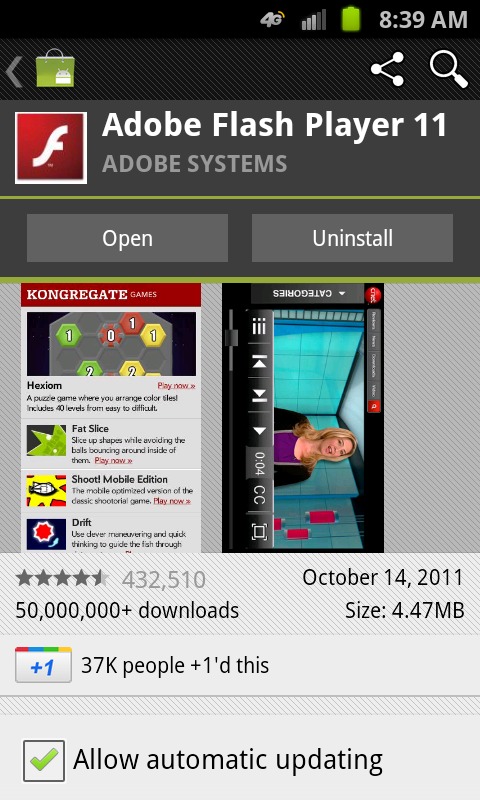
Much speculation has been going on this morning about Adobe’s future plans for the mobile platform, and now it’s finally official. After some recent cutbacks including hundreds of layoffs, Adobe will halt major development on Flash for Android, instead focusing on HTML5, with the effort that went into flash transitioning to the Adobe AIR platform for app development. Bug fixes and security support (a critical part of the attack-prone Flash) will continue, and at least one more major release will be posted, Flash 11.1.
Here’s the official line, straight from Adobe:
Our future work with Flash on mobile devices will be focused on enabling Flash developers to package native apps with Adobe AIR for all the major app stores. We will no longer continue to develop Flash Player in the browser to work with new mobile device configurations (chipset, browser, OS version, etc.) following the upcoming release of Flash Player 11.1 for Android and BlackBerry PlayBook. We will of course continue to provide critical bug fixes and security updates for existing device configurations. We will also allow our source code licensees to continue working on and release their own implementations.
What does this mean for Android users? In the short term, not much. Flash will still be available on the Android Market, and incremental updates will keep the player at least as stable as it is right now. It’s likely that the current Flash player should work for at least two or maybe even three more major releases of Android, though unfortunately it won’t be getting any performance increases beyond what hardware can boost.
Problems will begin to arise when web developers begin implementing newer versions of Flash for desktop browsers. At that point, videos, ads and other Flash elements designed on later versions of Flash and the Flash player may see some serious compatibility issues, or simply stop functioning. This is a good ways out, though – you can expect at lest a year’s wait before compatibility problems start appearing. On the desktop, Flash will continue to be updated as it is now.
While of course Flash has been a major selling point for Android since Froyo, getting it to work smoothly and efficiently is a chore for even top-end hardware, and it’s not surprising that Adobe had so much trouble adapting a system designed for desktop power to the mobile space. It is disappointing that they’ve decided to essentially quit after less than 18 months of public availability. Without official support, HTML5 will almost certainly take Flash’s place for websites designed for mobile video.










As a developer who has developed flash applications (not lame ads or videos stuff) – since v3 – I can say this is a major disappointment. Anyone building websites that use flash now would be crazy and wasting their time.. They might as well kill the desktop version too – force the change across the board instead of dragging it out longer.. AIR might still have a chance for cross platform development of apps, but I have a hard time trusting Adobe to not screw that up or kill it as well now..
Thanks again Steve!!
yep!sucks to be a fandroid now
All those isheeps are so happy.
I only want Flash for video support, so if every one swaps to a mobile system that will work every were I can live with it.
Problem is most blogs and videos that uses flash are not on html 5 format. And android will no longer play… how can they take flash out.. And maintain flash videos all-around
Useless controlling SOBs!
You didn’t even give me the option to PAY???!!!!
You just cancel work on Android compatibility all together?!!!!
Yes I said PAY… I Would Gladly PAY for my Samsung Galaxy S3, my Wife’s HTC Driod DNA, and our Newly Upgraded to Uselss ICS 10″ Tablet to play real Web Content!!!
You Just made Useless Bricks out of some of the best, up to date devices on the market, without even giving me the option to give you MONEY to keep them working!!!
IDIOTS!!!